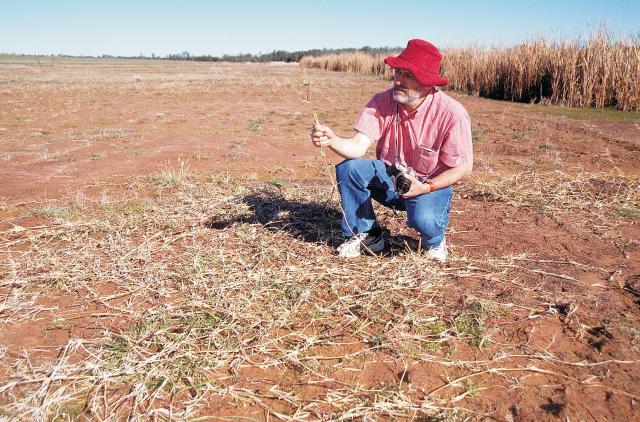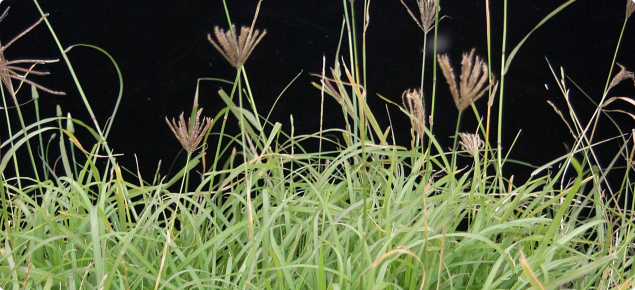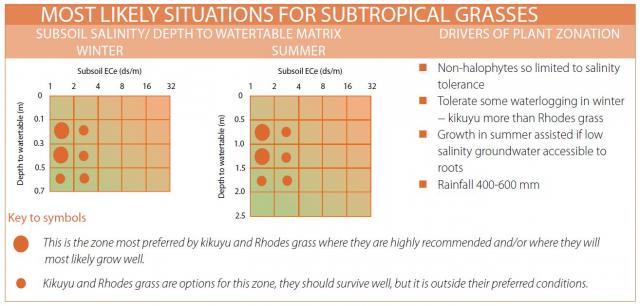Description
Rhodes grass is a subtropical tufted perennial C4 grass growing to a height of ~1.5 metres and spreading by means of stolons. These readily root, resulting in the rapid spread of the plant. The plant has distinctive brown coloured flowers consisting of 8–12 spikes clustered at the apex of a rachis (Figure 1).
The seeds are small and fluffy, averaging 3.3 to 4.4 million per kilogram.
Rhodes grass (Chloris gayana) has the following features:
- a creeping perennial which spreads by stolons (runners)
- is adapted to a range of soil and climatic conditions
- is easy to establish with good seedling vigour
- has moderate to high drought tolerance
- has low to moderate waterlogging tolerance
- has low salinity tolerance
- has moderate feed quality and palatability
- may not persist under stressful conditions.
Occurrence
Rhodes grass may have been introduced into Australia around 1900 from South Africa. There are many cultivars of Rhodes grass – see Rhodes grass in southern Western Australia for more detail.
Benefits
Rhodes grass is listed for saltland management because it can grow vigorously on the margins of saltland and use more water than annual pastures can.
Grazing
Manage grazing in summer and autumn to allow annual species (especially legumes) to establish in the stand following winter rains. Avoid heavy grazing during the first two season’s growth to allow the stand to thicken through stolon development.
Suitable sites
Rhodes grass has salt glands on the surface of its leaves, and observations are that it may grow on mildly saline sites (Figure 2).

We have ranked Rhodes grass as having similar tolerance to salinity and waterlogging as kikuyu (Figure 3), with much less tolerance of salinity than puccinellia and tall wheatgrass.
Common indicator species
On suitable sites: barley grass (Hordeum glaucum and H. leporinum), annual ryegrass (Lolium rigidum) or windmill grass (Chloris truncata – a native, warm season grass) – generally on the margins of saline sites.
On unsuitable sites: sea barleygrass (Hordeum marinum), marine or saltwater couch, and water buttons (Cotula coronopifolia) are generally towards the centre of saline sites.
Do not rely only on the presence or absence of indicator species. Before investing, always measure salinity and waterlogging on the site.
Salinity and waterlogging tolerance
Rhodes grass will grow well in soils with low salinity (2–4 dS/m) and to a lesser extent in soils with moderate salinity (4–8 dS/m).
Any increase in waterlogging reduces the tolerance of Rhodes grass to saline soils.
For the subtropical grasses (i.e. kikuyu and Rhodes grass), that have only limited salinity tolerance, surface water management can be critical. Diverting surface water away from the site is likely to improve productivity, and make a larger proportion of the saline area suitable for Rhodes grass.
Soil requirements
Rhodes grass is adapted to many soil types. It performs best on light to medium textured soils, with some establishment difficulties on heavy soils. Soils need to be reasonably well drained, as Rhodes grass has poor to moderate tolerance of waterlogging.
Rhodes grass does not tolerate extreme soil acidity and high exchangeable aluminium levels. High levels of soil fertility are required to support high yielding Rhodes grass pastures.
Climatic requirements
Rhodes grass is a C4 species that:
- requires temperatures in excess of 15°C for its photosynthetic pathway to operate
- means it is best suited to coastal regions, to the northern agricultural region in WA and to central and northern NSW
- will respond well to summer/autumn rain – for saline sites where salinity levels often build up over summer, this summer rainfall is probably essential for leaching salt out of the topsoil and keeping the salinity levels within the range that can be tolerated by the subtropical grasses
- has deep roots that can access shallow, low to mildly saline groundwater
- prefers frost-free climates, although it will survive in frost-prone areas that have summer rainfall.
Environmental weed risk
Rhodes grass has a high environmental weed risk in the Kimberley high rainfall areas, and medium environmental weed risk in the South-West. See Environmental Weed Risk Assessment results.
Establishment
Rhodes grass should be sown in spring at less than 1 cm depth and rates of 1–4 kg/ha. The plant has given poor establishment from seed on saltland trials in NSW. In this situation, establish Rhodes grass vegetatively, with grazing being withheld for a number of years to allow stands to thicken.




